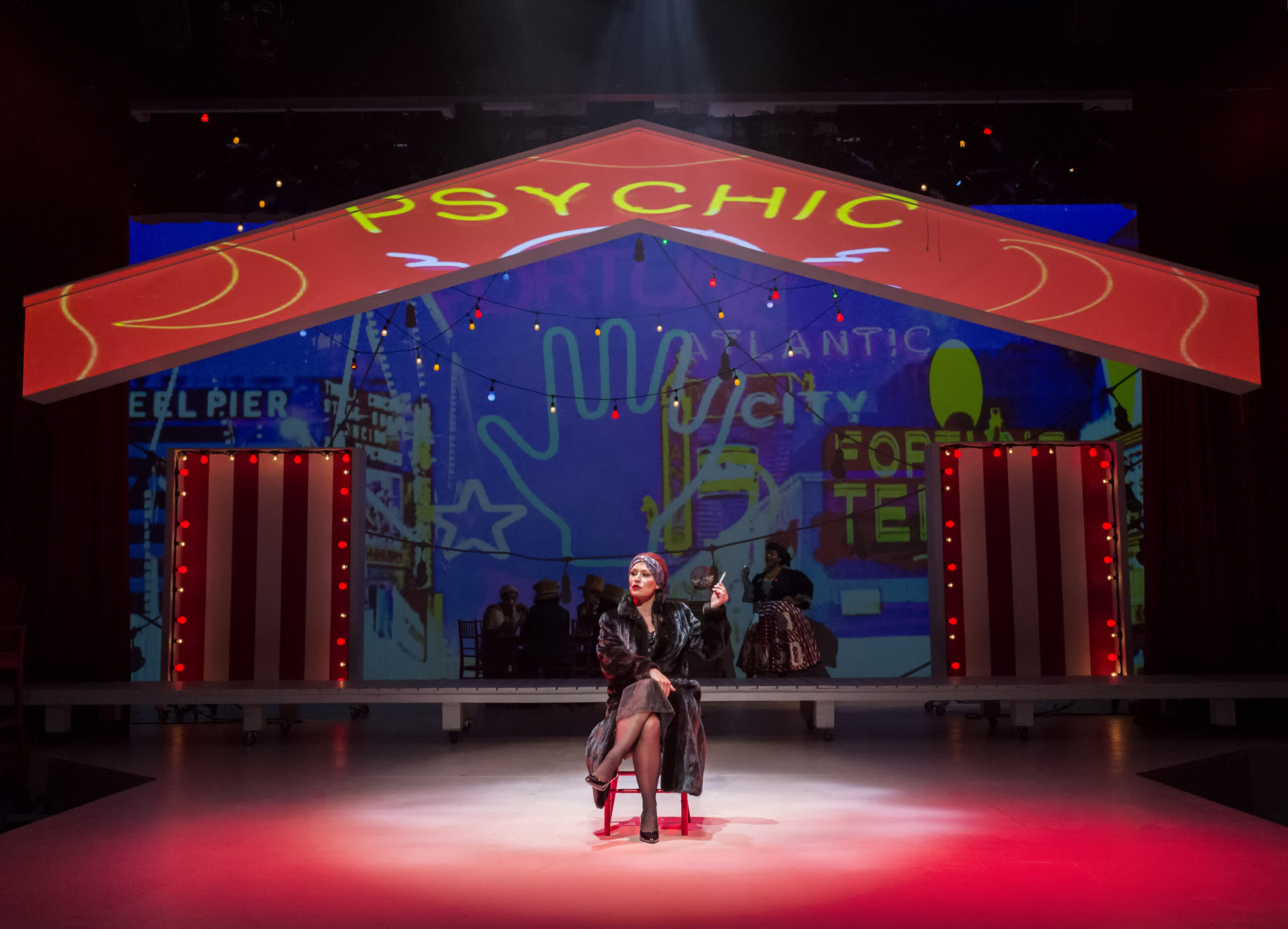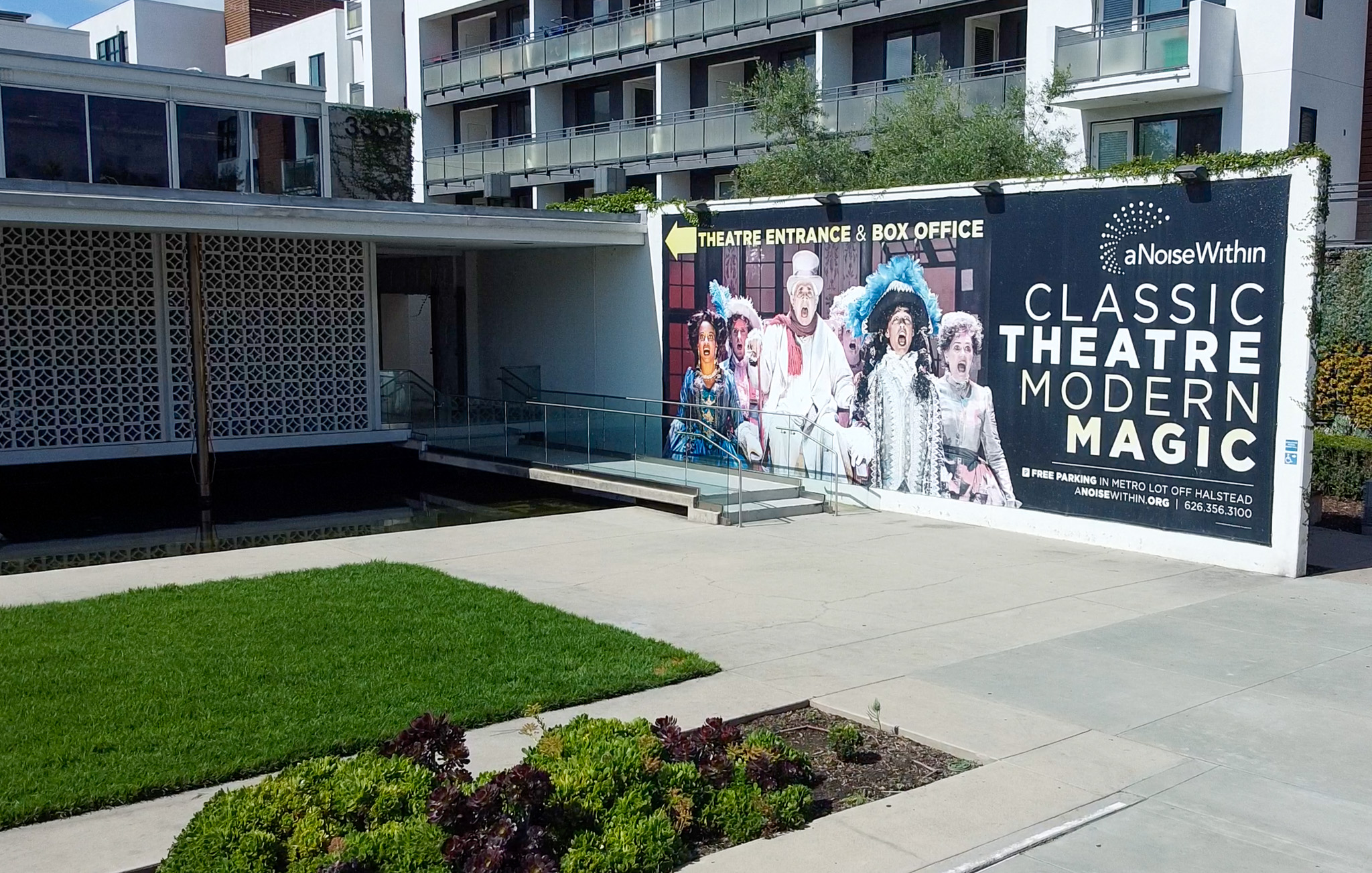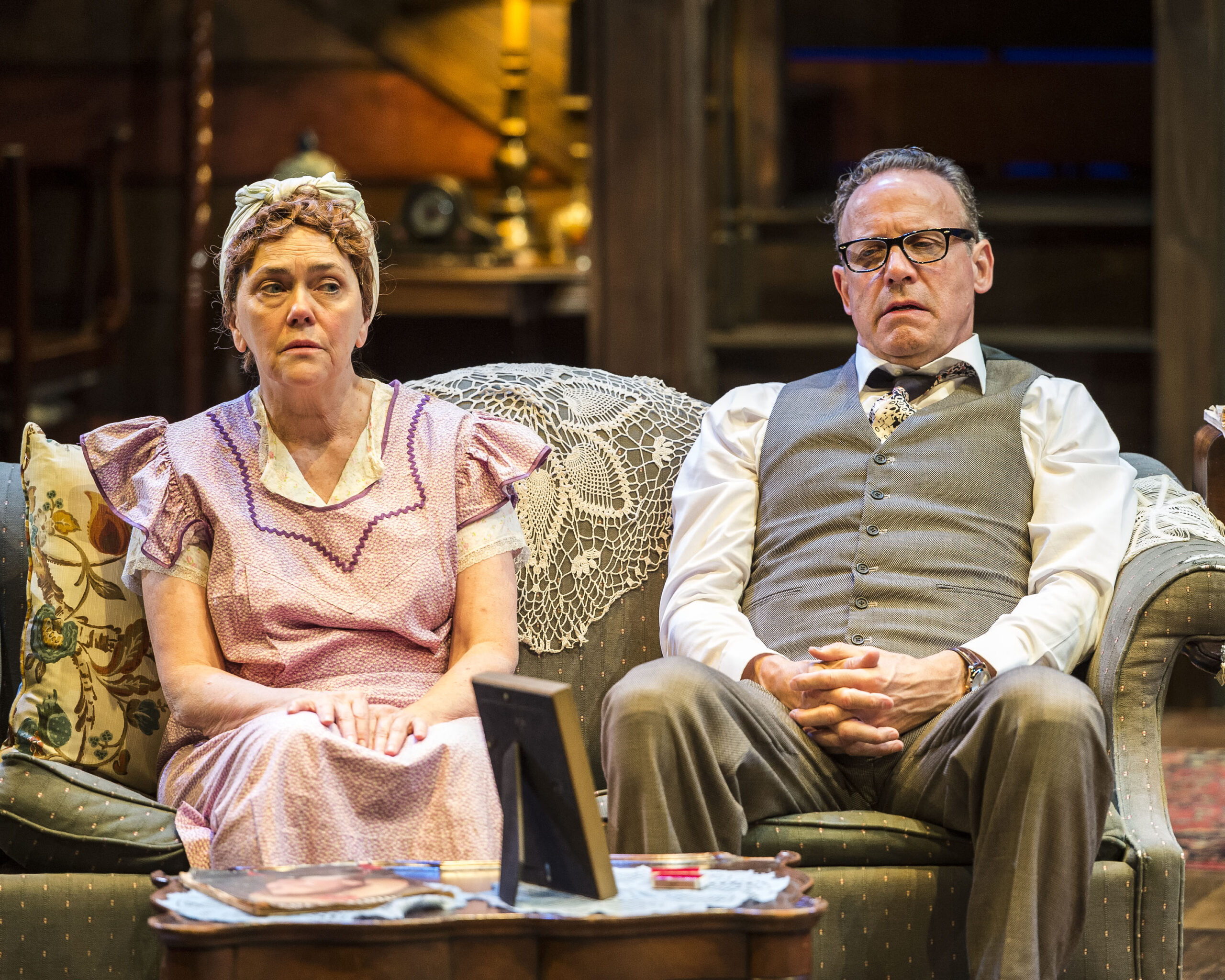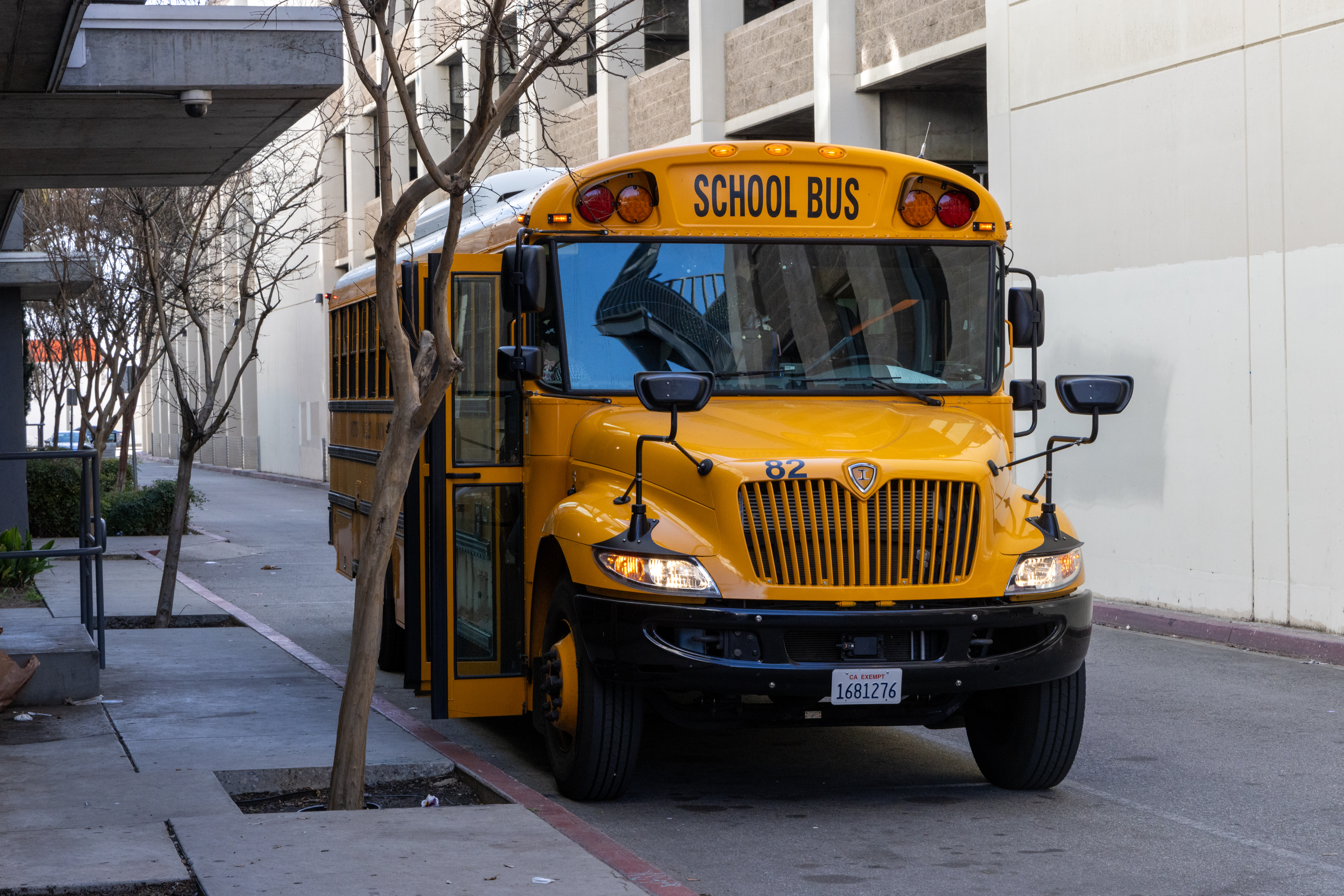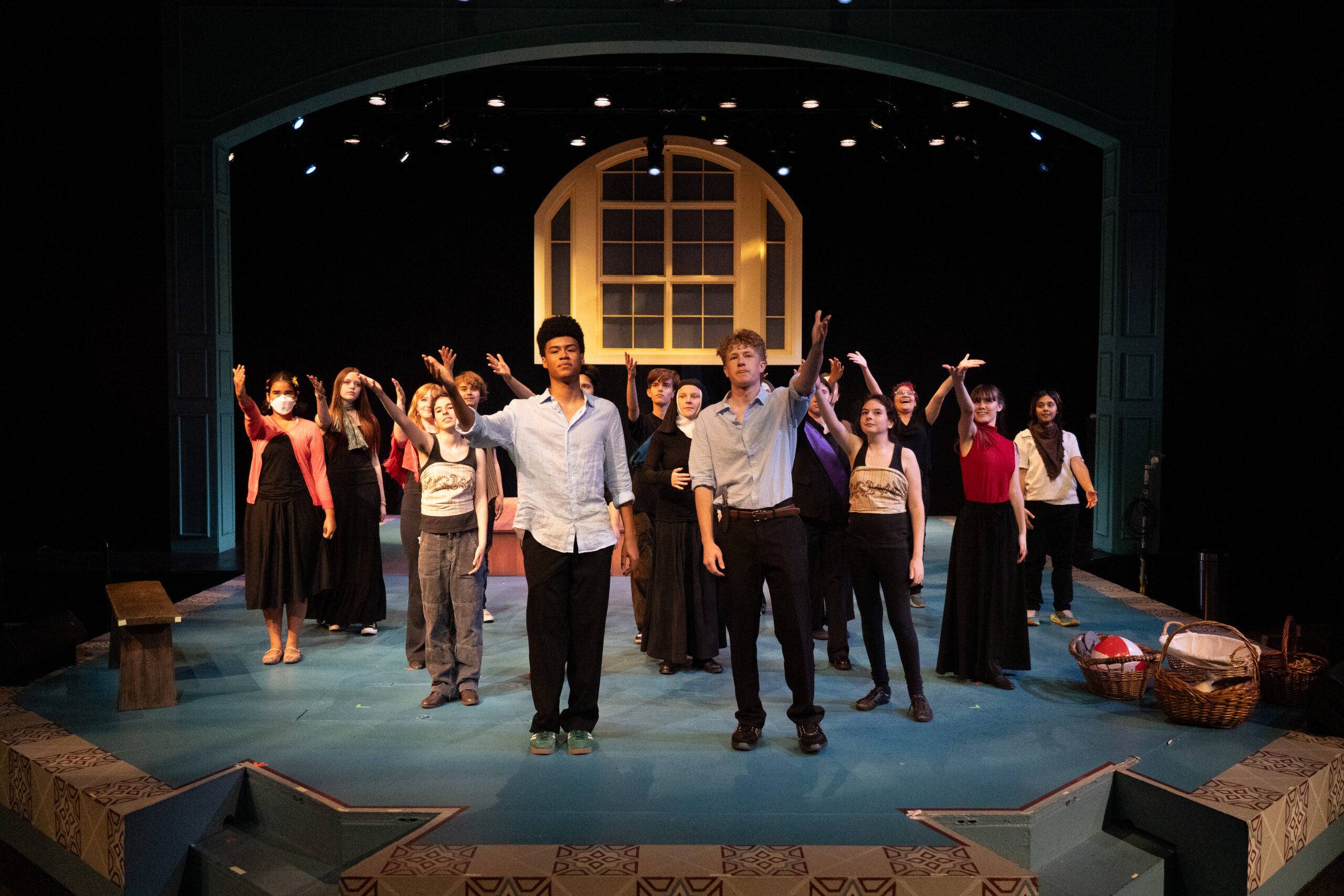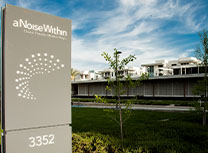Our History
A Noise Within started over 30 years ago with a simple dream; it has since evolved into a beloved Los Angeles institution that continually achieves a high artistic standard, challenges audiences, empowers students, and contributes to an inclusive, welcoming, and theatre-loving Los Angeles community.
In 1991, Geoff Elliott and Julia Rodriguez-Elliott (along with their colleague Art Manke) staged a production of William Shakespeare’s Hamlet at a time when classical theatre was rarely performed in the region. Though Geoff and Julia had little money to their names – having withdrawn their last $3,000 from the bank for the production – what they had was a city filled with well-trained actors and access to a great, empty space: the Masonic Temple in Glendale. Previously a place of worship, the Elliotts and Manke built a makeshift stage in the Temple and flanked three sides of it with the wooden church pews left behind by the previous occupants. The thrust configuration, now a signature of A Noise Within, gave their early audiences an intimate theatrical experience.
“From the beginning, we gravitated toward sets that were spare and provocative; we knew we were not interested in big, huge, representational sets,” said Julia Rodriguez-Elliott. “A mark of true artistry to be able to tell the story with the bare minimum – and we have always had a scrappy imagination! We’ve always been interested in transformational environments that pull your attention to the actor, the words, and the story. Our conservatory training valued language and storytelling, and we were lucky to have found a large community of actors in Los Angeles that shared our values.”
Geoff added, “The one requirement we always had of our audiences was that they brought their imaginations with them. And the thrust stage, which plunges audiences into the action, has an immediacy to it. These were the first guiding principles of A Noise Within: thoughts of how to stage the classics, questions about what makes theatre meaningful and satisfying for the audience, and a desire to create a fulfilling experience for our artists.”
Julia continued, “After the success of Hamlet, we were energized to work with our colleague Sabin Epstein, who wanted to do Congreve’s The Way of the World. Actors’ resumes poured in – and soon enough, we had enough language-based actors that we could easily populate the two plays. That is how we found our way to the repertory theatre we still practice today.”
The Elliotts’ training ground, the famed American Conservatory Theatre in San Francisco, was a strong proponent of repertory theatre (in which different productions are performed in rotation, with the same troupe of cast members performing different roles from night to night). Classical rotating repertory is a time-tested theatre tradition, rare in the U.S. regional theatre scene, but with the unique ability to build strong community among artists, between artists and their audience, and among audience members.
A Noise Within adopted a repertory theatre model with its second and third productions, and by the company’s third season, actors were given the opportunity to perform multiple roles across three thematically linked plays. Over the years, A Noise Within has strengthened and expanded its working relationship with Actors’ Equity Association (the Actors’ Union); this commitment to professionalism has helped ANW grow its theatre from 60 to 99 seats, then to 145, 283, and recently, 324.
In April 1992, following ANW’s The Way of the World and The Merchant of Venice, Los Angeles Times drama critic Sylvie Drake said, “This is a well-pedigreed company of actors who know how to deliver the classics. They mostly hail from the country’s better-known classical hatcheries such as San Francisco’s American Conservatory Theatre, Oregon’s Shakespeare Festival at Ashland, the American Repertory Theatre, South Coast Repertory, and the Mark Taper Forum […] A Noise Within is one of the freshest classical companies to come down the pike. One devoutly hopes its noise grows louder.”
Three decades later, A Noise Within has become one of America’s most successful theatre companies; our unwavering artistic vision is a driving factor in that success. “We focus on timeless works that speak to the human condition,” says Julia, “It’s important for us to present these epics in an intimate setting, told with a personal and contemporary perspective – after all, what good are all these grand, sweeping narratives if no one can relate to them?”
To-date, ANW has presented over 200 productions, amassing 35 LA Stage Alliance Ovation nominations and five awards (including Best Season for 2017/2018’s “Entertaining Courage”), 32 Los Angeles Drama Critics Circle Awards (including two Polly Warfield Awards for Excellence), and becoming the youngest company ever to receive the Margaret Harford Award for Distinguished Achievement. In 2012, ANW Producing Artistic Directors Geoff Elliott and Julia Rodriguez-Elliott were honored with the inaugural alumni “Contributions to the Field Award” by American Conservatory Theatre. This award honors distinguished alumni and supporters who have contributed significant leadership in the field of theatre locally and nationally beyond their role as actors and founders. Their fellow honorees were The William Randolph Hearst Foundation, Annette Bening, and Elizabeth Banks.
Julia and Geoff are very aware of the word ‘region’ in regional theatre – they endeavor to create theatre that is of and for community, just as the early champions of the regional theatre movement envisioned. They have always felt that their energies are about serving the community they live in, and not necessarily about exporting productions to other cities. Not surprisingly, many of their most important associations are with partners in the region: the City of Pasadena (including with Mayor Bogaard, who sits on ANW’s Board of Directors), the owner of the parcel of land for their current theatre, SMV Technology Partners (David Worrell and Jeff Allen), and Metro (LA). These connections have helped foster growth to the benefit of both the community and ANW’s long–term artistic goals.
Today, A Noise Within operates out of its permanent theatrical home in Pasadena (which the company recognizes as the traditional lands of the Gabrielino-Tongva People). In 2008, ANW began fundraising for this new theatre complex, leading a successful $13.5 million capital campaign to build its new space at 3352 East Foothill Blvd.: a three story, 30,000 square foot facility complete with rehearsal space, scene and costume shops, classrooms, administrative offices, and more. The state-of-the-art Neo-formalist facility was built on the site of an historical landmark designed by acclaimed 20th century architect, Edward Durell Stone – most noted for Radio City Music Hall, the Center Theatre in Rockefeller Center, the Museum of Modern Art, and the John F. Kennedy Center for the Performing Arts (Kennedy Center) in Washington D.C. The most notable architectural feature – a mid-century modern façade dating from 1958 – was entirely preserved. The new venue has allowed ANW to grow its audience in considerable ways, consistently surpassing its previous box office and attendance records each year. In a typical year, ANW annually serves more than 51,000 patrons from across Southern California and beyond.
In 2018, A Noise Within launched two new initiatives that have radically redefined ANW as an inclusive community hub where art happens, is celebrated and discussed, and where theatre comes to life in many ways for many people.
The first of these programs is Noise Now, a community place-making initiative that includes readings, adaptations, multi-genre performances, dance, art installations, and non-traditional theatre presented collaboratively with innovative organizations working in and around Los Angeles. To quote Jonathan Muñoz-Proulx – ANW’s first Director of Cultural Programming, who helped ANW launch the program – “Noise Now is an opportunity to expand our family by engaging with our neighboring communities and peer organizations. It’s more than an audience development initiative—it is a commitment to being a great neighbor, to building relationships with audiences and artists, and to demonstrating our eagerness to listen well and respond courageously.” The program engages partners that primarily serve underrepresented audiences, presenting work that illuminates overlap between our mission and the missions of our collaborators.
The second of these initiatives is ANW’s annual “Relaxed Performance” program, designed for patrons with Autism Spectrum Disorder, Developmental Delay, and other Disorders of Social Interaction and Communication. These performances are open to all, but specifically designed for young patrons whose sensory disorders can make it challenging for them to sit through a traditional live theatre experience (due to dramatic and often overwhelming changes in scenery, lights, and sound). These Relaxed Performances maintain the recognized excellence that is a hallmark for ANW and are delivered by the same professional cast, while employing reduced lighting and sound, a shortened script, and designated activity/relaxation spaces to help create a sensory-friendly environment for these young people and their families. One parent who attended our most recent Relaxed Performance said, “It’s one thing to be accepting of families with autism – it’s another thing to be embraced. And today we were embraced.” ANW is one of the few theatres in Southern California that offers Relaxed Performances, and through the development of the program, has become a local expert and industry leader when it comes to sensory-friendly experiences; ANW has been invited to consult on similar programs for the Natural History Museum, The California Science Center, and The Huntington Library and Garden.
Finally, A Noise Within’s commitment to student audiences is central to its mission. Each year, ANW dedicates a third of its performances and 30% of its operating budget to education and outreach programs. Through vital foundation and government support, ANW provides support to schools in need including transportation for students to the theatre; free and reduced-cost tickets to attend live performances; post-show discussions with the artists; in-class workshops; standards-based study guides, and more. Over its history, ANW has served more than 285,000 students and teachers; in a typical year, program participants include 18,000 students and teachers from 192 schools across 41 school districts.

